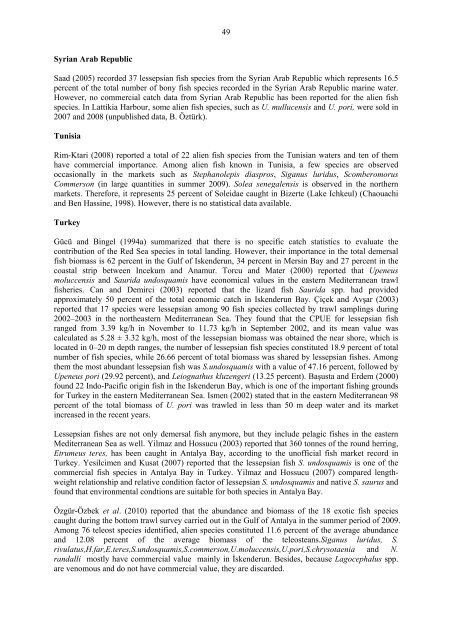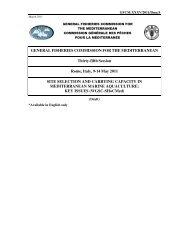Status of alien species in the Mediterranean and Black Sea
Status of alien species in the Mediterranean and Black Sea
Status of alien species in the Mediterranean and Black Sea
Create successful ePaper yourself
Turn your PDF publications into a flip-book with our unique Google optimized e-Paper software.
Syrian Arab Republic<br />
49<br />
Saad (2005) recorded 37 lessepsian fish <strong>species</strong> from <strong>the</strong> Syrian Arab Republic which represents 16.5<br />
percent <strong>of</strong> <strong>the</strong> total number <strong>of</strong> bony fish <strong>species</strong> recorded <strong>in</strong> <strong>the</strong> Syrian Arab Republic mar<strong>in</strong>e water.<br />
However, no commercial catch data from Syrian Arab Republic has been reported for <strong>the</strong> <strong>alien</strong> fish<br />
<strong>species</strong>. In Lattikia Harbour, some <strong>alien</strong> fish <strong>species</strong>, such as U. mullucensis <strong>and</strong> U. pori, were sold <strong>in</strong><br />
2007 <strong>and</strong> 2008 (unpublished data, B. Öztürk).<br />
Tunisia<br />
Rim-Ktari (2008) reported a total <strong>of</strong> 22 <strong>alien</strong> fish <strong>species</strong> from <strong>the</strong> Tunisian waters <strong>and</strong> ten <strong>of</strong> <strong>the</strong>m<br />
have commercial importance. Among <strong>alien</strong> fish known <strong>in</strong> Tunisia, a few <strong>species</strong> are observed<br />
occasionally <strong>in</strong> <strong>the</strong> markets such as Stephanolepis diaspros, Siganus luridus, Scomberomorus<br />
Commerson (<strong>in</strong> large quantities <strong>in</strong> summer 2009). Solea senegalensis is observed <strong>in</strong> <strong>the</strong> nor<strong>the</strong>rn<br />
markets. Therefore, it represents 25 percent <strong>of</strong> Soleidae caught <strong>in</strong> Bizerte (Lake Ichkeul) (Chaouachi<br />
<strong>and</strong> Ben Hass<strong>in</strong>e, 1998). However, <strong>the</strong>re is no statistical data available.<br />
Turkey<br />
Gücü <strong>and</strong> B<strong>in</strong>gel (1994a) summarized that <strong>the</strong>re is no specific catch statistics to evaluate <strong>the</strong><br />
contribution <strong>of</strong> <strong>the</strong> Red <strong>Sea</strong> <strong>species</strong> <strong>in</strong> total l<strong>and</strong><strong>in</strong>g. However, <strong>the</strong>ir importance <strong>in</strong> <strong>the</strong> total demersal<br />
fish biomass is 62 percent <strong>in</strong> <strong>the</strong> Gulf <strong>of</strong> Iskenderun, 34 percent <strong>in</strong> Mers<strong>in</strong> Bay <strong>and</strong> 27 percent <strong>in</strong> <strong>the</strong><br />
coastal strip between Incekum <strong>and</strong> Anamur. Torcu <strong>and</strong> Mater (2000) reported that Upeneus<br />
moluccensis <strong>and</strong> Saurida undosquamis have economical values <strong>in</strong> <strong>the</strong> eastern <strong>Mediterranean</strong> trawl<br />
fisheries. Can <strong>and</strong> Demirci (2003) reported that <strong>the</strong> lizard fish Saurida spp. had provided<br />
approximately 50 percent <strong>of</strong> <strong>the</strong> total economic catch <strong>in</strong> Iskenderun Bay. Çiçek <strong>and</strong> Avşar (2003)<br />
reported that 17 <strong>species</strong> were lessepsian among 90 fish <strong>species</strong> collected by trawl sampl<strong>in</strong>gs dur<strong>in</strong>g<br />
2002–2003 <strong>in</strong> <strong>the</strong> nor<strong>the</strong>astern <strong>Mediterranean</strong> <strong>Sea</strong>. They found that <strong>the</strong> CPUE for lessepsian fish<br />
ranged from 3.39 kg/h <strong>in</strong> November to 11.73 kg/h <strong>in</strong> September 2002, <strong>and</strong> its mean value was<br />
calculated as 5.28 ± 3.32 kg/h, most <strong>of</strong> <strong>the</strong> lessepsian biomass was obta<strong>in</strong>ed <strong>the</strong> near shore, which is<br />
located <strong>in</strong> 0–20 m depth ranges, <strong>the</strong> number <strong>of</strong> lessepsian fish <strong>species</strong> constituted 18.9 percent <strong>of</strong> total<br />
number <strong>of</strong> fish <strong>species</strong>, while 26.66 percent <strong>of</strong> total biomass was shared by lessepsian fishes. Among<br />
<strong>the</strong>m <strong>the</strong> most abundant lessepsian fish was S.undosquamis with a value <strong>of</strong> 47.16 percent, followed by<br />
Upeneus pori (29.92 percent), <strong>and</strong> Leiognathus kluzengeri (13.25 percent). Başusta <strong>and</strong> Erdem (2000)<br />
found 22 Indo-Pacific orig<strong>in</strong> fish <strong>in</strong> <strong>the</strong> Iskenderun Bay, which is one <strong>of</strong> <strong>the</strong> important fish<strong>in</strong>g grounds<br />
for Turkey <strong>in</strong> <strong>the</strong> eastern <strong>Mediterranean</strong> <strong>Sea</strong>. Ismen (2002) stated that <strong>in</strong> <strong>the</strong> eastern <strong>Mediterranean</strong> 98<br />
percent <strong>of</strong> <strong>the</strong> total biomass <strong>of</strong> U. pori was trawled <strong>in</strong> less than 50 m deep water <strong>and</strong> its market<br />
<strong>in</strong>creased <strong>in</strong> <strong>the</strong> recent years.<br />
Lessepsian fishes are not only demersal fish anymore, but <strong>the</strong>y <strong>in</strong>clude pelagic fishes <strong>in</strong> <strong>the</strong> eastern<br />
<strong>Mediterranean</strong> <strong>Sea</strong> as well. Yilmaz <strong>and</strong> Hossucu (2003) reported that 360 tonnes <strong>of</strong> <strong>the</strong> round herr<strong>in</strong>g,<br />
Etrumeus teres, has been caught <strong>in</strong> Antalya Bay, accord<strong>in</strong>g to <strong>the</strong> un<strong>of</strong>ficial fish market record <strong>in</strong><br />
Turkey. Yesilcimen <strong>and</strong> Kusat (2007) reported that <strong>the</strong> lessepsian fish S. undosquamis is one <strong>of</strong> <strong>the</strong><br />
commercial fish <strong>species</strong> <strong>in</strong> Antalya Bay <strong>in</strong> Turkey. Yilmaz <strong>and</strong> Hossucu (2007) compared lengthweight<br />
relationship <strong>and</strong> relative condition factor <strong>of</strong> lessepsian S. undosquamis <strong>and</strong> native S. saurus <strong>and</strong><br />
found that environmental condtions are suitable for both <strong>species</strong> <strong>in</strong> Antalya Bay.<br />
Özgür-Özbek et al. (2010) reported that <strong>the</strong> abundance <strong>and</strong> biomass <strong>of</strong> <strong>the</strong> 18 exotic fish <strong>species</strong><br />
caught dur<strong>in</strong>g <strong>the</strong> bottom trawl survey carried out <strong>in</strong> <strong>the</strong> Gulf <strong>of</strong> Antalya <strong>in</strong> <strong>the</strong> summer period <strong>of</strong> 2009.<br />
Among 76 teleost <strong>species</strong> identified, <strong>alien</strong> <strong>species</strong> constituted 11.6 percent <strong>of</strong> <strong>the</strong> average abundance<br />
<strong>and</strong> 12.08 percent <strong>of</strong> <strong>the</strong> average biomass <strong>of</strong> <strong>the</strong> teleosteans.Siganus luridus, S.<br />
rivulatus,H.far,E.teres,S.undosquamis,S.commerson,U.moluccensis,U.pori,S.chrysotaenia <strong>and</strong> N.<br />
r<strong>and</strong>alli mostly have commercial value ma<strong>in</strong>ly <strong>in</strong> İskenderun. Besides, because Lagocephalus spp.<br />
are venomous <strong>and</strong> do not have commercial value, <strong>the</strong>y are discarded.
















